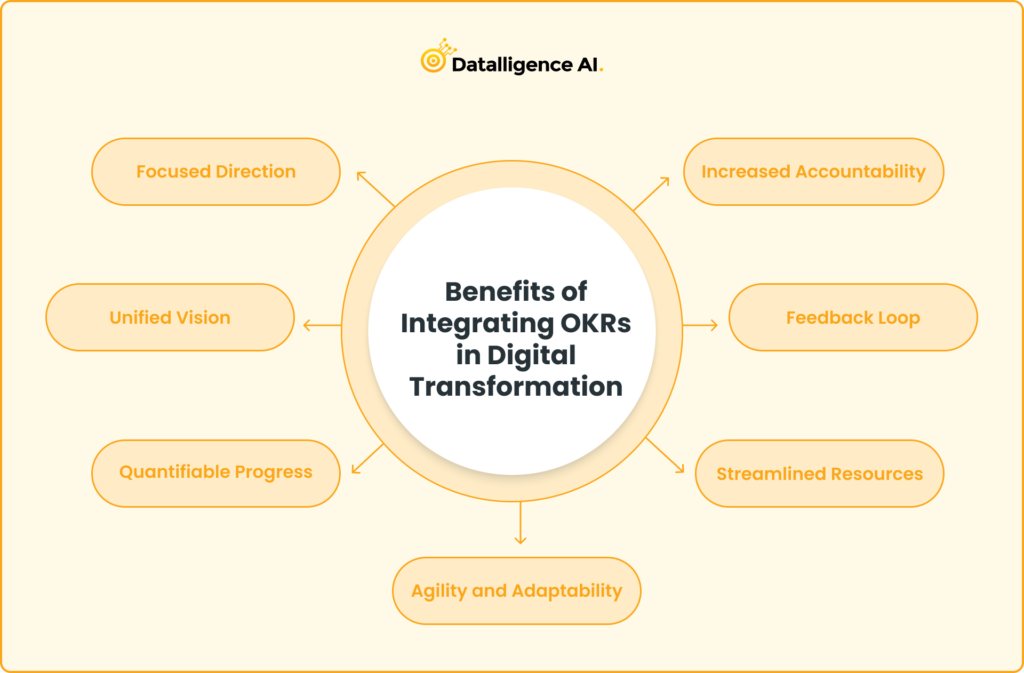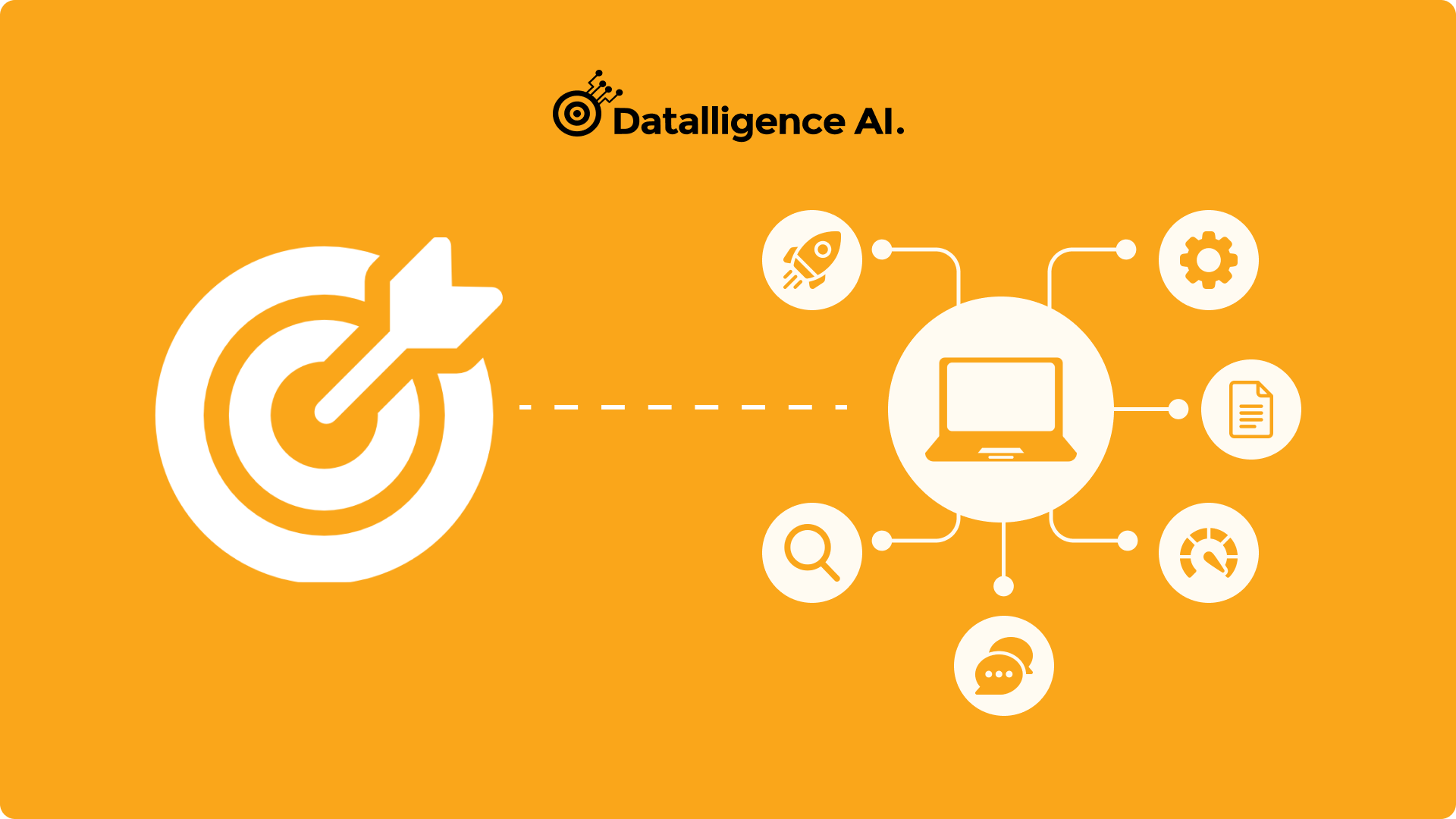In an era where digital evolution is no longer an option but a necessity, businesses are consistently seeking methodologies and frameworks that can streamline their transformation processes. One such effective tool is the Objectives and Key Results framework, which has proved to be instrumental in driving digital transformations across organizations of varying scales.
Through this blog, we will delve deep into how to play a crucial role in reshaping businesses and why companies should incorporate them.
Why Digital Transformation is Revolutionizing Business?
Digital transformation is not just about integrating technology into business operations; it’s about fundamentally reshaping how businesses function, create value, and interact with their customers. This revolution goes beyond mere automation of existing processes. Instead, it reimagines how businesses can leverage the vast potential of digital technologies to innovate and offer unprecedented services and experiences.
As a result, companies that embrace digital transformation are equipped to better analyze data, engage with customers in meaningful ways, and swiftly adapt to changing market dynamics. By eliminating manual inefficiencies and unlocking new capabilities, businesses can stay ahead of competitors, become more proactive to market shifts, and position themselves for sustained growth in an increasingly digital-centric world.
Digital Transformation Cycle with OKRs

➔ Initiation Phase
Begin by diagnosing the organization’s current digital stance. This involves understanding existing processes, and tools, and pinpointing areas that require improvement.
➔ Strategy Development Phase
Goal Definition: Envision where the company desires to be in the digital domain. Establish clear, long-term objectives.
Roadmapping: Break down the overarching goal into actionable steps or phases, ensuring a logical progression and sequence.
➔ Action Phase
Implementation: Convert strategies into tangible actions. This might involve deploying new technologies, revamping existing processes, or introducing innovative digital initiatives.
Feedback Loop: As these initiatives get rolled out, it’s crucial to establish a continuous mechanism for feedback to ensure alignment with objectives and desired outcomes.
➔ Reflection Phase
Evaluation: After a set period or after certain milestones, take a step back to examine the outcomes against the set OKRs. This is where organizations identify successes, challenges, and areas of learning.
Optimization: Based on the insights derived from evaluations, refine strategies, tools, or approaches to ensure better outcomes in the subsequent cycles.
➔ And Back to Initiation…
After the Reflection Phase, the journey doesn’t conclude. The organization re-enters the Initiation Phase for a fresh assessment, considering the insights and changes from the previous cycle, making certain that the digital transformation remains a continuous and evolving journey.
OKRs in Digital Transformation: Making Tech Changes Tangible
Navigating the realm of digital transformation can be like wandering in a vast, intricate maze. But what if you had a map? That’s precisely what OKRs bring to the table.
Here’s a simple overview:
1. Clear Direction with OKRs in Digital Transformation
Instead of just saying “We want to embrace digital technology”, an organization can use OKRs to specify: “We aim to improve our online sales by 20% (Objective) by implementing a new e-commerce platform and enhancing user experience (Key Results)”.
Example: A clothing retailer wanting to expand online can have an OKR like “Increase website traffic by 30% by launching a mobile app and improving site speed.”
2. Measurable Outcomes
Digital transformation can be overwhelming. With myriad technologies and strategies to consider, how do you know you’re on the right track? OKRs make progress quantifiable.
Example: If an organization aims to improve customer service through digital channels, the OKR could be, “Reduce response time on digital queries by 50% and achieve a 90% customer satisfaction score on digital interactions.”
3. Alignment and Focus
OKRs ensure that every department, from tech to marketing, is aligned in the digital transformation journey.
Example: A restaurant chain wanting to improve online orders could have an OKR where the tech team works on app functionality while the marketing team focuses on promotions for app users.
4. Adaptable Strategy
Digital landscapes change. OKRs in Digital Transformation offer an adaptable framework. If a strategy isn’t working, the OKR can be adjusted to pivot the approach.
Example: An online bookstore finds its chatbot isn’t effective. The new OKR could be “Enhance customer service by integrating a better AI-driven chatbot and training staff for online queries.”
To put it simply, consider Digital Transformation as the destination, and OKRs as the GPS – guiding, providing checkpoints, and ensuring you’re on the right track.
Benefits Of Integrating OKRs In Digital Transformation

Digital transformation, with its broad scope and potential, can often seem overwhelming to organizations. That’s where OKRs come into play, offering clarity and direction.
Let’s delve into their crucial benefits:
Focused Direction
Digital transformation can feel like navigating through a vast ocean of possibilities. OKRs act as a compass, pinpointing the exact direction a company needs to take. This way, businesses don’t just adopt technology for its sake but ensure it serves a definite purpose.
Unified Vision
In the complex realm of digital endeavors, teams can easily find themselves working in silos. OKRs foster a shared vision, ensuring every team, from IT to marketing, is rowing in the same direction.
Quantifiable Progress
The beauty of OKRs lies in their measurable outcomes. It’s one thing to aim for ‘improved user experience’ and another to target a 20% reduction in user complaints. The latter gives a clearer picture of progress and success.
Agility and Adaptability
Digital landscapes shift rapidly. OKRs provide organizations the flexibility to pivot as they learn and grow. This ensures that their digital transformation journey remains relevant, effective, and aligned with the latest technological advancements.
Increased Accountability
When objectives are clear and key results are measurable, every team member knows their role in the digital transformation process. This clarity fosters responsibility, driving teams to put in their best efforts.
Feedback Loop
OKRs are not set in stone. They encourage periodic reviews, including 360-degree feedback, allowing businesses to assess, recalibrate, and refine their digital strategies based on real-world feedback and results.
Streamlined Resources
Instead of investing haphazardly in various digital tools and platforms, OKRs ensure resources – both time and money – are channeled effectively toward achieving specific objectives.
5 Best Digitalization OKRs Examples
Digitalization OKRs help organizations prioritize, measure, and achieve their digital goals.
Here are some concrete examples:
1. E-Commerce Business
Aiming to deliver a seamless online shopping experience.
Objective: Improve online sales and user experience.
- KR 1: Achieve a 25% increase in monthly online sales.
- KR 2: Reduce website load time to under 2 seconds.
- KR 3: Achieve a 90% customer satisfaction rate on post-purchase surveys.
2. SaaS Company
Focused on maximizing user engagement with their software solution.
Objective: Enhance software product adoption among users.
- KR 1: Increase the number of daily active users by 20%.
- KR 2: Achieve a 95% customer retention rate.
- KR 3: Conduct 5 webinars or training sessions to introduce new features.
3. Financial institutions striving to modernize customer interactions and offer digital conveniences.
Objective: Digitize customer service operations for increased efficiency.
- KR 1: Implement an AI-driven chatbot to handle 50% of customer inquiries.
- KR 2: Reduce average customer wait time on calls by 30%.
- KR 3: Achieve a 15% increase in customer sign-ups for online banking.
4. Manufacturing Company
Keen on harnessing the potential of IoT for optimal asset utilization.
Objective: Implement IoT (Internet of Things) for better asset management.
- KR 1: Digitally monitor and maintain 80% of factory machinery using IoT sensors.
- KR 2: Reduce machinery downtime by 20% through predictive maintenance.
- KR 3: Achieve a 10% overall increase in production efficiency.
5. Educational Institution
Committed to revolutionizing the academic journey through digital tools.
Objective: Enhance the digital learning experience for students.
- KR 1: Increase enrollment in online courses by 30%.
- KR 2: Ensure 95% uptime for the online learning platform.
- KR 3: Collect and act on feedback from 70% of students regarding the digital tools used.
Datalligence: Your Partner in Digital Transformation
While understanding the benefits of OKRs in digital transformation is one thing, effectively implementing and monitoring them is another. That’s where Datalligence comes into play.
Datalligence is a cutting-edge OKR platform designed to assist organizations in setting, tracking, and achieving their objectives in the digital realm. With intuitive dashboards, collaborative tools, and analytics capabilities, Datalligence makes the integration of OKRs in your digital transformation journey seamless and efficient.
Whether you’re just beginning your digital transformation or looking to optimize your current strategies, Datalligence is the partner you need to ensure you’re on the path to success. Talk to our Experts and Coaches and gain more insights
In Conclusion
Digital transformation, when paired with the strategic framework of OKRs, can propel organizations to unprecedented heights. It’s about harnessing the power of technology with a clear, measurable vision in mind. And with platforms like Datalligence by your side, the road to digital excellence becomes clearer and more achievable. Embrace the synergy of OKRs in Digital Transformation and set your organization on a trajectory toward sustainable growth and success.











